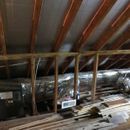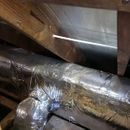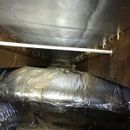HVAC Equipment and Spray Foam Installation
Good morning everyone,
As usual, I have learned a ton from the relevant GBA articles and discussions on open cell spray foam in conditioned and unconditioned attics, including the risk of new humidity issues after installation. The situation below doesn’t seem to be covered exactly in these past articles and discussions, so I’d love to tap your expertise.
Building situation (pictures attached): 1944-built brick and block home in zone 4a with original slate roof on 1×6 decking, no soffits but small eave air gaps and gable vents on both side walls. Attic is finished, conditioned space with 2×8 rafters and knee walls that contain heat pump air handler and wrapped duct work for registers serving attic and bedrooms in the floor below. The knee walls will be covered by drywall except where maintenance access doors will be needed for servicing the air handler. I have already installed 1 1/2″ vent channels under the decking using 1″ polyiso from the small eave openings to beneath the gable vents. However, vent channels are not air-sealed all the way to eaves because I was counting on the spray foam to finish the job where I couldn’t reach.
Problem: spray foam contractors are understandably concerned about safely and successfully applying closed cell foam behind the air handler and duct work because of lack of ability to get spray gun and good line of sight into the eaves. They have proposed spraying up to 10″ of open cell foam under the polyiso vents, proud of the rafters, until they can transition to about 4 1/2″ of closed cell to fill the rafter bays up the slopes from where they are not obstructed by the HVAC equipment all the way to and across the underside of the vent channel below the ridge. The costly alternative is to take apart and move the HVAC equipment to facilitate installing closed cell and then reinstall everything.
Question: is my insulation contractor’s proposal to use open cell spray foam behind the HVAC equipment (and closed cell under the rest of the vent channels) an acceptable approach that limits the risk of increasing humidity or other problems in the home?
Thanks in advance for your help!
Kyle
GBA Detail Library
A collection of one thousand construction details organized by climate and house part













Replies
I'm not a building science expert but I sprayed foam. I'm with the contractors. Even open cell will be more pour than spray. They hope the open cell will expand into the spaces but once they start there's now way to know if they've used enough to fill the space.
Another issue is getting the close cell foam adhered to old wood. If it pulls away it's not air sealed so it's better to air seal the baffles beforehand.
Thanks for your reply. Are you with the contractors in recommending open cell, or you would recommend removing the air handler and duct work?
- Remove the duct work. The downside isn't worth the risk.
- Might also consider continuous insulation over the rafters.
Thanks John. Other experts out there agree or have differing views?
I would remove the ductwork. It's difficult for the crews to maneuver the spray foam gun and hose assembly in confined spaces, which means it may not be possible for them to get a good application in spaces where they have restricted access. I've run into that on some of my own projects, actually. It's also true that if they can't see the foam expanding, they can't be sure they got a good fill/application.
If you have the ability to remove the ductwork to open up the area that needs insulating, that's your best/safest option.
Bill